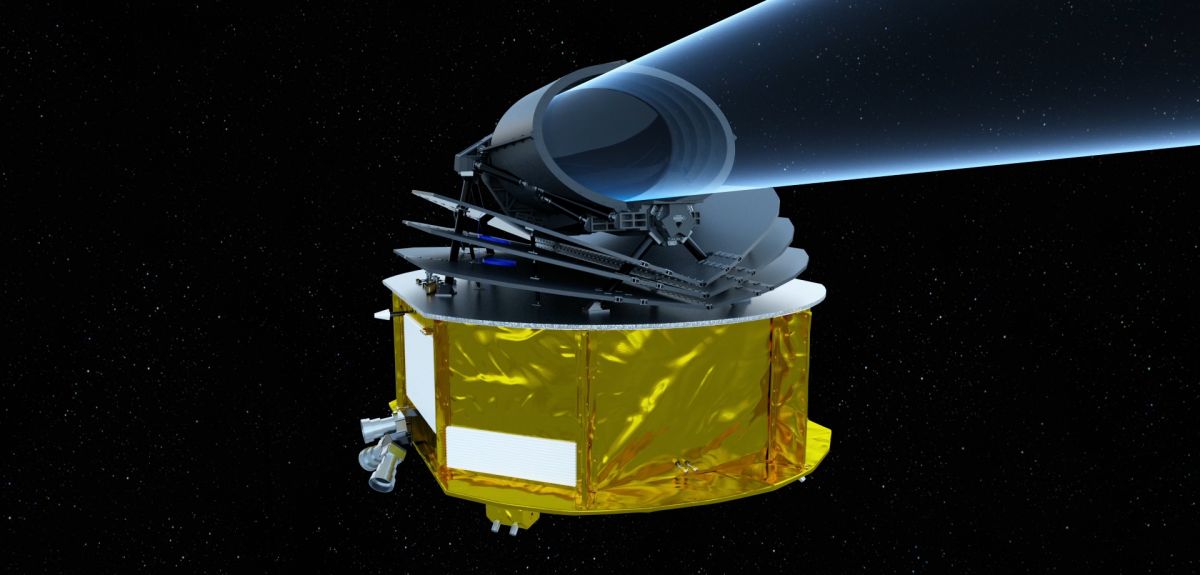
Image Credit: ESA/STFC RAL Space/UCL/UK Space Agency/ ATG Medialab
The European Space Agency formally adopts Ariel, the exoplanet explorer
The European Space Agency (ESA) have formally adopted Ariel, the first mission dedicated to study the nature, formation and evolution of exoplanets.
More than 50 institutes from 17 countries, including the University of Oxford, have been working over the past five years to develop the science goals and design the instrumentation which will enable Ariel to survey a diverse sample of around 1000 planets outside our own solar system.
Professor Neil Bowles, from the Department of Physics, said: ‘The team in Oxford have been involved with the Ariel mission since it was originally proposed in 2014 and it’s fantastic to see it progress to mission adoption. Our team is working closely with our colleagues at RAL Space and University of Lisbon, Portugal, to develop the optical ground test equipment, allowing the Ariel instrument to be characterised under space-like conditions here on Earth before being integrated into the rest of spacecraft and launched.’
It is extremely exciting that Ariel has been adopted by ESA. I have been working on the science case for this mission since I was an undergraduate student and now as a final year DPhil student it feels like a full circle moment.
Jake Taylor, DPhil student at the Department of Physics, University of Oxford, said: ‘It is extremely exciting that Ariel has been adopted by ESA. I have been working on the science case for this mission since I was an undergraduate student and now as a final year DPhil student it feels like a full circle moment. This telescope will revolutionise the study of exoplanet atmospheres and I feel honoured that I was involved in development stages.
‘The science case involves developing the questions we want to answer and how we can use the instrument to answer them. One way in which we did this was to perform various studies to determine what information we can extract from the range of observations that we will be able to obtain from the instrument.’
Ariel has passed major feasibility reviews and has been formally adopted into the program of future missions for implementation. It will survey about 1000 planets outside our solar system during its lifetime and will unveil the nature, formation and evolution of a large and assorted sample of planets around different types of stars in our galaxy.
Ariel will be the first mission dedicated to measuring the chemical composition and atmospheric thermal properties of hundreds of transiting exoplanets.
The mission has passed a rigorous set of reviews which it has been undergoing throughout 2020 to prove the technical feasibility and science case and has now received approval from ESA’s member states, confirming that the team can work towards a launch in 2029.
UK institutions have provided the leadership and planning for Ariel, including University College London, the Science and Technology Facilities Council’s (STFC) RAL Space, Technology Department and UK Astronomy Technology Centre, Cardiff University and the University of Oxford. UK contributions are funded by the UK Space Agency.
Ariel will be the first mission dedicated to measuring the chemical composition and atmospheric thermal properties of hundreds of transiting exoplanets. Ariel will give us a picture of a diverse range of exoplanets: from extremely hot to temperate, from gaseous to rocky planets orbiting close to their parent stars.
By looking specifically at hot planets, scientists are expecting to build an understanding of the formation of planets and their evolution. At hotter temperature, which in some cases it can be more than 2000’C, a greater number of exotic molecules will be visible to Ariel. The instruments will then be able to determine what the atmospheres are made up of and provide scientists a unique insight into the planet’s internal composition and the formation history of the planetary system
The Ariel team is taking a very open approach providing rapid access to data and even encouraging enthusiasts to help select targets and characterise stars. Much of the data will be available to both the science community and general public immediately.
The instruments will be able to determine what the atmospheres are made up of and provide scientists a unique insight into the planet’s internal composition and the formation history of the planetary system
Ariel will have a meter-class telescope primary mirror to collect visible and infrared light from distant star systems. An infrared spectrometer will spread the light into a ‘rainbow’ and extract the chemical fingerprints of gases in the planets’ atmospheres, which become embedded in starlight when a planet passes in front or behind the star. A photometer, a spectrometer and guidance system will capture information on the presence on clouds in the atmospheres of the exoplanets and will allow the spacecraft to point to the target star with high stability and precision.
The Ariel mission consortium teams from across Europe will now move on to build and prototype their designs for the payload of Ariel and plan for receiving and processing the data. The industrial contractor for the spacecraft bus, which will support the payload coming from the nationally funded consortium teams, will be selected in the summer 2021.
Find out more: http://ariel-spacemission.eu
 Learning centre celebrates 10 years working with young people in Oxford
Learning centre celebrates 10 years working with young people in Oxford
 Expert Comment: The point of the pope. Why His Holiness matters (even if you’re not a Catholic)
Expert Comment: The point of the pope. Why His Holiness matters (even if you’re not a Catholic)
 Child heart disease found to be more likely if mother has anaemia during pregnancy
Child heart disease found to be more likely if mother has anaemia during pregnancy